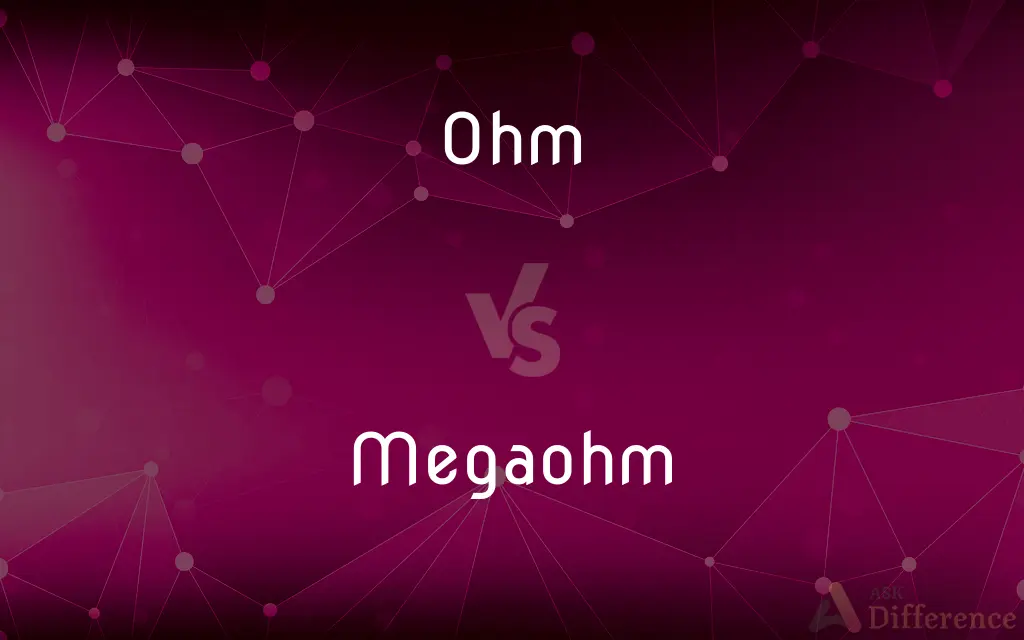Ohm vs. Megaohm — What's the Difference?
By Fiza Rafique & Urooj Arif — Updated on April 24, 2024
Ohm (Ω) is a unit of electrical resistance, commonly used for small resistances, while a megaohm (MΩ) represents one million ohms, typically for high resistance values.

Difference Between Ohm and Megaohm
Table of Contents
ADVERTISEMENT
Key Differences
Ohm, denoted as Ω, is the standard unit of electrical resistance in the International System of Units (SI). It quantifies how much an object resists electrical current. In contrast, a megaohm, symbolized as MΩ, is equal to one million ohms, used to measure much larger resistances. This distinction is crucial in applications from electronics to electrical engineering.
In practical use, devices like resistors are often rated in ohms when dealing with currents in circuits like household electronics. On the other hand, megaohms are more relevant in scenarios involving higher resistance values, such as insulation resistance in electrical installations.
The measurement range for ohms typically involves objects with low to moderate resistance levels, such as wires or small electronic components. Whereas, megaohms are used to describe the resistance of components that significantly impede electrical flow, such as the insulating materials in cables.
Ohm readings are common in everyday electrical and electronic devices, indicating their designed resistance to current. Conversely, measurements in megaohms often indicate a component's suitability for high voltage applications, ensuring safety and functionality.
Understanding the difference between ohm and megaohm measurements helps in selecting the right components for specific applications, ensuring that devices operate safely under the intended electrical loads. Megaohm measurements are particularly important in high-voltage environments to prevent equipment failure.
ADVERTISEMENT
Comparison Chart
Unit Size
1 Ohm
1,000,000 Ohms
Common Usage
Small electronic components, household wiring
High voltage equipment, insulation testing
Electrical Applications
Everyday electronic devices
Safety and high voltage applications
Symbol
Ω
MΩ
Measurement Range
Low to moderate resistance
Very high resistance
Compare with Definitions
Ohm
Pertains to small to moderate resistance levels.
Most household appliances operate within a range of 1 to 100 ohms.
Megaohm
A unit equal to one million ohms.
The insulation resistance was 2 megaohms.
Ohm
SI unit for measuring electrical resistance.
Ohm's Law uses ohms to relate voltage and current.
Megaohm
Pertinent in high voltage applications.
Megaohm readings ensure the equipment handles high voltages safely.
Ohm
Used in calculating electrical current flow.
They calculated the current using the resistance in ohms.
Megaohm
Indicates substantial electrical resistance.
The barrier prevents current flow, showing a resistance of several megaohms.
Ohm
A unit of electrical resistance.
The resistor has a value of 10 ohms.
Megaohm
Used for high resistance measurements.
High voltage insulators are tested in megaohms.
Ohm
Represents the resistance between two points.
A wire's resistance was measured at 5 ohms.
Megaohm
Essential for safety in electrical engineering.
Their safety standards require components to have at least 1 megaohm resistance.
Ohm
The ohm (symbol: Ω) is the SI derived unit of electrical resistance, named after German physicist Georg Ohm. Various empirically derived standard units for electrical resistance were developed in connection with early telegraphy practice, and the British Association for the Advancement of Science proposed a unit derived from existing units of mass, length and time, and of a convenient scale for practical work as early as 1861.
Megaohm
One million (106) ohms, abbreviated as MΩ.
Ohm
The SI unit of electrical resistance, transmitting a current of one ampere when subjected to a potential difference of one volt.
Ohm
The SI unit of electrical resistance, equal to the resistance of a conductor through which a current of one ampere flows given a one-volt potential across the conductor. See Table at measurement.
Ohm
In the International System of Units, the derived unit of electrical resistance; the electrical resistance of a device across which a potential difference of one volt causes a current of one ampere. Symbol: Ω
Ohm
The standard unit in the measure of electrical resistance, being the resistance of a circuit in which a potential difference of one volt produces a current of one ampére. As defined by the International Electrical Congress in 1893, and by United States Statute, it is a resistance substantially equal to 109 units of resistance of the C. G. S. system of electro-magnetic units, and is represented by the resistance offered to an unvarying electric current by a column of mercury at the temperature of melting ice 14.4521 grams in mass, of a constant cross-sectional area, and of the length of 106.3 centimeters. As thus defined it is called the international ohm.
Ohm
A unit of electrical resistance equal to the resistance between two points on a conductor when a potential difference of one volt between them produces a current of one ampere
Ohm
German physicist who formulated Ohm's Law (1787-1854)
Common Curiosities
How many ohms are in a megaohm?
There are one million ohms in a megaohm.
When is a megaohm used instead of an ohm?
Megaohms are used instead of ohms when measuring very high resistance values, typically in safety and high voltage applications.
Why are different resistance scales used in electrical engineering?
Different resistance scales are used to accurately measure and manage the wide range of resistance values encountered in various applications, from small electronic devices to large electrical systems.
How does temperature affect resistance measured in ohms or megaohms?
Generally, as temperature increases, the resistance of materials measured in both ohms and megaohms also increases.
Is there a visual difference between devices measured in ohms and those in megaohms?
Typically, no visual difference is based solely on the unit of measurement, though devices designed for higher resistance may have different construction features for safety.
What is an ohm?
An ohm is a unit of electrical resistance measuring how strongly a material opposes the flow of electric current.
How do I convert megaohms to kiloohms?
To convert megaohms to kiloohms, multiply the number of megaohms by 1,000 (1 MΩ = 1,000 kΩ).
Can resistance be negative in ohms or megaohms?
No, resistance measured in ohms or megaohms is always a positive value.
Are there units larger than megaohm?
Yes, larger units include the gigaohm (GΩ), which is equal to one billion ohms.
What is the symbol for ohm and megaohm?
The symbol for ohm is Ω, and for megaohm, it is MΩ.
How do you measure resistance in ohms and megaohms?
Resistance in ohms and megaohms is measured using a multimeter or specific resistance measuring devices.
What common devices use megaohm measurements?
Devices like insulation testers and high-voltage equipment typically use megaohm measurements.
Why is understanding the difference between ohm and megaohm important?
Understanding the difference is crucial for selecting appropriate components for electrical circuits and ensuring safety and efficiency in electrical applications.
What role do ohms play in Ohm's Law?
In Ohm's Law, ohms quantify the resistance, which is used to calculate the voltage or current in a circuit.
What errors can affect measurements in ohms and megaohms?
Common errors include incorrect device calibration, environmental factors like temperature and humidity, and improper contact with the material being measured.
Share Your Discovery

Previous Comparison
Surveyor vs. Surveyee
Next Comparison
Mc vs. EmceeAuthor Spotlight
Written by
Fiza RafiqueFiza Rafique is a skilled content writer at AskDifference.com, where she meticulously refines and enhances written pieces. Drawing from her vast editorial expertise, Fiza ensures clarity, accuracy, and precision in every article. Passionate about language, she continually seeks to elevate the quality of content for readers worldwide.
Co-written by
Urooj ArifUrooj is a skilled content writer at Ask Difference, known for her exceptional ability to simplify complex topics into engaging and informative content. With a passion for research and a flair for clear, concise writing, she consistently delivers articles that resonate with our diverse audience.
















































